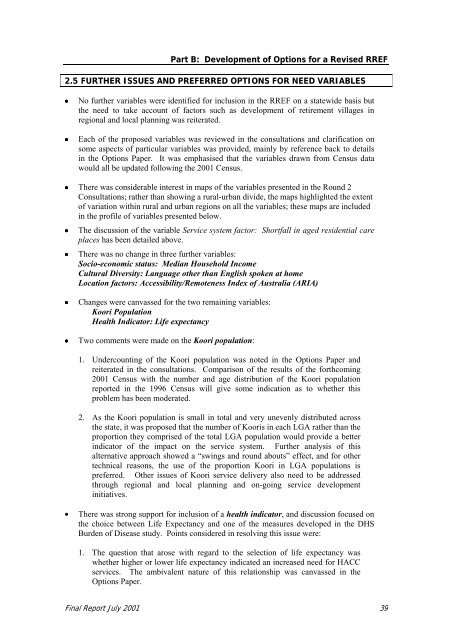Final Report on RREF 2001 - Department of Health
Final Report on RREF 2001 - Department of Health
Final Report on RREF 2001 - Department of Health
You also want an ePaper? Increase the reach of your titles
YUMPU automatically turns print PDFs into web optimized ePapers that Google loves.
Part B: Development <strong>of</strong> Opti<strong>on</strong>s for a Revised <strong>RREF</strong><br />
2.5 FURTHER ISSUES AND PREFERRED OPTIONS FOR NEED VARIABLES<br />
• No further variables were identified for inclusi<strong>on</strong> in the <strong>RREF</strong> <strong>on</strong> a statewide basis but<br />
the need to take account <strong>of</strong> factors such as development <strong>of</strong> retirement villages in<br />
regi<strong>on</strong>al and local planning was reiterated.<br />
• Each <strong>of</strong> the proposed variables was reviewed in the c<strong>on</strong>sultati<strong>on</strong>s and clarificati<strong>on</strong> <strong>on</strong><br />
some aspects <strong>of</strong> particular variables was provided, mainly by reference back to details<br />
in the Opti<strong>on</strong>s Paper. It was emphasised that the variables drawn from Census data<br />
would all be updated following the <strong>2001</strong> Census.<br />
• There was c<strong>on</strong>siderable interest in maps <strong>of</strong> the variables presented in the Round 2<br />
C<strong>on</strong>sultati<strong>on</strong>s; rather than showing a rural-urban divide, the maps highlighted the extent<br />
<strong>of</strong> variati<strong>on</strong> within rural and urban regi<strong>on</strong>s <strong>on</strong> all the variables; these maps are included<br />
in the pr<strong>of</strong>ile <strong>of</strong> variables presented below.<br />
• The discussi<strong>on</strong> <strong>of</strong> the variable Service system factor: Shortfall in aged residential care<br />
places has been detailed above.<br />
• There was no change in three further variables:<br />
Socio-ec<strong>on</strong>omic status: Median Household Income<br />
Cultural Diversity: Language other than English spoken at home<br />
Locati<strong>on</strong> factors: Accessibility/Remoteness Index <strong>of</strong> Australia (ARIA)<br />
• Changes were canvassed for the two remaining variables:<br />
Koori Populati<strong>on</strong><br />
<strong>Health</strong> Indicator: Life expectancy<br />
• Two comments were made <strong>on</strong> the Koori populati<strong>on</strong>:<br />
1. Undercounting <strong>of</strong> the Koori populati<strong>on</strong> was noted in the Opti<strong>on</strong>s Paper and<br />
reiterated in the c<strong>on</strong>sultati<strong>on</strong>s. Comparis<strong>on</strong> <strong>of</strong> the results <strong>of</strong> the forthcoming<br />
<strong>2001</strong> Census with the number and age distributi<strong>on</strong> <strong>of</strong> the Koori populati<strong>on</strong><br />
reported in the 1996 Census will give some indicati<strong>on</strong> as to whether this<br />
problem has been moderated.<br />
2. As the Koori populati<strong>on</strong> is small in total and very unevenly distributed across<br />
the state, it was proposed that the number <strong>of</strong> Kooris in each LGA rather than the<br />
proporti<strong>on</strong> they comprised <strong>of</strong> the total LGA populati<strong>on</strong> would provide a better<br />
indicator <strong>of</strong> the impact <strong>on</strong> the service system. Further analysis <strong>of</strong> this<br />
alternative approach showed a “swings and round abouts” effect, and for other<br />
technical reas<strong>on</strong>s, the use <strong>of</strong> the proporti<strong>on</strong> Koori in LGA populati<strong>on</strong>s is<br />
preferred. Other issues <strong>of</strong> Koori service delivery also need to be addressed<br />
through regi<strong>on</strong>al and local planning and <strong>on</strong>-going service development<br />
initiatives.<br />
• There was str<strong>on</strong>g support for inclusi<strong>on</strong> <strong>of</strong> a health indicator, and discussi<strong>on</strong> focused <strong>on</strong><br />
the choice between Life Expectancy and <strong>on</strong>e <strong>of</strong> the measures developed in the DHS<br />
Burden <strong>of</strong> Disease study. Points c<strong>on</strong>sidered in resolving this issue were:<br />
1. The questi<strong>on</strong> that arose with regard to the selecti<strong>on</strong> <strong>of</strong> life expectancy was<br />
whether higher or lower life expectancy indicated an increased need for HACC<br />
services. The ambivalent nature <strong>of</strong> this relati<strong>on</strong>ship was canvassed in the<br />
Opti<strong>on</strong>s Paper.<br />
<str<strong>on</strong>g>Final</str<strong>on</strong>g> <str<strong>on</strong>g>Report</str<strong>on</strong>g> July <strong>2001</strong> 39
















